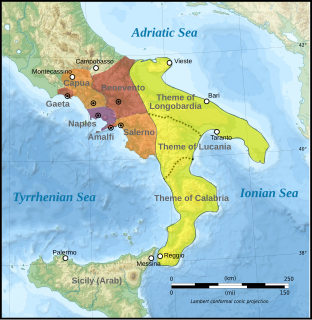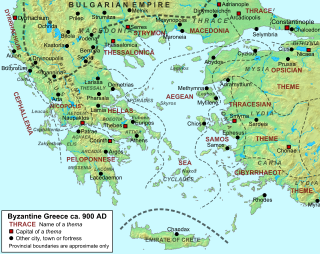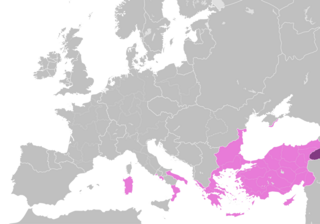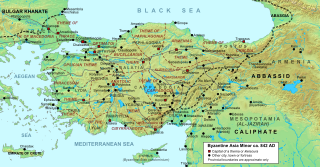The title of ek prosopou (Greek : ἐκ προσώπου), meaning "representative", was widely used in the middle Byzantine Empire (9th–12th centuries) for deputies of various office holders.

Greek is an independent branch of the Indo-European family of languages, native to Greece, Cyprus and other parts of the Eastern Mediterranean and the Black Sea. It has the longest documented history of any living Indo-European language, spanning more than 3000 years of written records. Its writing system has been the Greek alphabet for the major part of its history; other systems, such as Linear B and the Cypriot syllabary, were used previously. The alphabet arose from the Phoenician script and was in turn the basis of the Latin, Cyrillic, Armenian, Coptic, Gothic, and many other writing systems.

The Byzantine Empire, also referred to as the Eastern Roman Empire and Byzantium, was the continuation of the Roman Empire in its eastern provinces during Late Antiquity and the Middle Ages, when its capital city was Constantinople. It survived the fragmentation and fall of the Western Roman Empire in the 5th century AD and continued to exist for an additional thousand years until it fell to the Ottoman Turks in 1453. During most of its existence, the empire was the most powerful economic, cultural, and military force in Europe. Both the terms "Byzantine Empire" and "Eastern Roman Empire" are historiographical exonyms created after the end of the realm; its citizens continued to refer to their empire simply as the Roman Empire, or Romania (Ῥωμανία), and to themselves as "Romans".
The title could be applied in a generic sense to any senior official, such as the strategos of a theme, who was in a sense the deputy of the Byzantine Emperor. In a more technical sense, as used in the Taktika or lists of offices of the 9th–11th centuries, it was used by subordinate officials who deputized for a strategos or other provincial governor or one of the central government ministries for a specific district (called ekprosopike by Kekaumenos). The same usage is also attested in the ecclesiastical hierarchy.

Strategos or Strategus, plural strategoi, is used in Greek to mean military general. In the Hellenistic world and the Byzantine Empire the term was also used to describe a military governor. In the modern Hellenic Army it is the highest officer rank.

The themes or themata were the main military/administrative divisions of the middle Byzantine Empire. They were established in the mid-7th century in the aftermath of the Slavic invasion of the Balkans and Muslim conquests of parts of Byzantine territory, and replaced the earlier provincial system established by Diocletian and Constantine the Great. In their origin, the first themes were created from the areas of encampment of the field armies of the East Roman army, and their names corresponded to the military units that had existed in those areas. The theme system reached its apogee in the 9th and 10th centuries, as older themes were split up and the conquest of territory resulted in the creation of new ones. The original theme system underwent significant changes in the 11th and 12th centuries, but the term remained in use as a provincial and financial circumscription until the very end of the Empire.
Kekaumenos is the family name of the otherwise unidentified Byzantine author of the Strategikon, a manual on military and household affairs composed c. 1078. He was apparently of Georgian-Armenian origin and the grandson of the doux of Hellas. Despite relevant suppositions, there exists no concrete evidence that he is the famous 11th century general Katakalon Kekaumenos, or his son.











